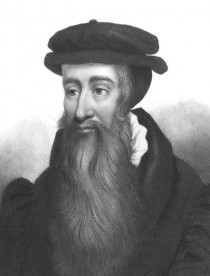
John Knox was born in Haddington, near Edinburgh around 1514. In 1536 he graduated from St Andrews University and was ordained a priest. He became a notary and tutor, but in 1543 was converted to Christ and embraced the Reformed faith. He was much influenced by the preacher George Wishart, and became his bodyguard.
After Wishart was martyred in St Andrews in 1546, and Cardinal Beaton was murdered in retaliation, the Protestants took refuge in St Andrews Castle, which was besieged. Having been Wishart’s bodyguard meant that Knox himself was now in danger, and after being harried around Scotland for a while he ended up joining the group in St Andrews Castle in 1547. Knox was officially appointed preacher, and preached his first sermon there on Daniel 7:24-25. With the help of the French – summoned by the Queen Regent, Mary of Guise – the castle fell, and Knox became a galley slave in France for 19 months.
Released in 1549, he preached in Berwick and Newcastle, England with much power and success. Refusing the bishopric of Rochester, he was forced into hiding when Catholic Mary Tudor was crowned. Knox fled to France, then Zurich and Calvin’s Geneva; he then pastored an English congregation in Frankfurt. Forced out by liturgical disputes in 1555, Knox returned to Geneva and pastored an English congregation there. The same year he returned secretly to Scotland, married Marjory Bowes and preached widely. Condemned for heresy in Scotland, he returned to Geneva with his wife and mother-in-law (Elizabeth Bowes), from where he penned in 1558 his famous The First Blast of the Trumpet Against the Monstrous Regiment of Women, advocating rebellion against ungodly rulers.
With the death of Mary Tudor the following year, Knox was again able to return to Scotland, where he preached a sermon condemning ‘idolatry’, and this led to rebellion. In 1560, the Reformation Parliament adopted the Protestant Scots Confession. Knox’s first wife, Marjory died the same year, after bearing him two sons. Knox helped to write the First Book of Discipline in 1561.
Catholic Mary Queen of Scots returned from France, and Knox had the first of several interviews with her. From this time until his death the pulpit of St Giles became his platform. He married again – Margaret Stewart – in 1564; she was to bear him three daughters. In 1564 he penned much of his History of the Reformation of Religion in Scotland. John Knox died in Edinburgh in 1572 and was buried at St Giles’s Cathedral.
[See also John Howie, The Scots Worthies (Banner of Truth, 1995), pp. 48-66, and Chapter 1 (‘John Knox and “the Battle”‘) in Iain H. Murray, A Scottish Christian Heritage (Banner of Truth, 2006).]